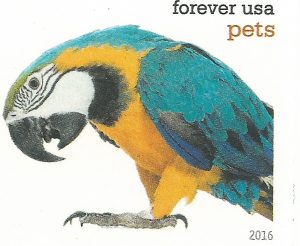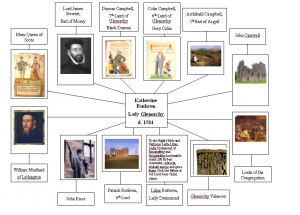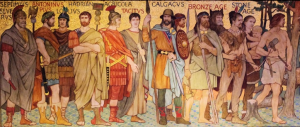May 13th Scots book of days
May 13 1159 Sir Roast McDuck (fictional clan McDuck) hatched. Known for gluttony, and being one of the richest clans in Scotland until 1189. Sir Roast was asked by William the Lion, King of Scotland (later styled William 1st of Scotland, when William of Orange became King in 1688) to offer most of his clan’s treasure in order to fulfill Richard, Richard Cœur de Lion, or Richard the Lionheart, King of England’s terms for a treaty that had been signed between them. The treaty said that if William offered to Richard 10,000 marks, William (and Scotland) would be freed of his oath of subservience to Richard’s father (Henry 2nd). The patriotic Roast obeyed his king’s wishes. That obedience later led to financial problems and decline of the fictional clan McDuck. Read at December 4th Scots book of days.
 Effigy (c. 1199) of Richard I at Fontevraud Abbey, Anjou. Richard’s father, Henry 2nd King, was son of Matida the Empress, daughter of Matilda Atheling Stewart of Scotland, daughter of Malcolm 3rd MacCrinan, 19th King of Scots and his Queen Saint Margaret of Scotland.
Effigy (c. 1199) of Richard I at Fontevraud Abbey, Anjou. Richard’s father, Henry 2nd King, was son of Matida the Empress, daughter of Matilda Atheling Stewart of Scotland, daughter of Malcolm 3rd MacCrinan, 19th King of Scots and his Queen Saint Margaret of Scotland.
 Sir Roast McDuck (born 1159 flourished 1198. Fictional clan McDUck) Although the clan is probably fictional, it has made a lot of money for Disney, and with the paucity of records from 900 years ago, who knows but what ducks could talk then, like parrots do now?
Sir Roast McDuck (born 1159 flourished 1198. Fictional clan McDUck) Although the clan is probably fictional, it has made a lot of money for Disney, and with the paucity of records from 900 years ago, who knows but what ducks could talk then, like parrots do now?
 1390 Robert The Steward, Earl Strathearn, afterward Robert II, King of Scots died (ODNB xviii1226, 1230) (ancestor of Andrew Stewart 2nd Lord Ochiltree) 1424 James (later styled 1st ), Stewart King of Scots, arrests uncle Walter Stewart who is imprisoned at Bass Rock.
1390 Robert The Steward, Earl Strathearn, afterward Robert II, King of Scots died (ODNB xviii1226, 1230) (ancestor of Andrew Stewart 2nd Lord Ochiltree) 1424 James (later styled 1st ), Stewart King of Scots, arrests uncle Walter Stewart who is imprisoned at Bass Rock.
1453 – Princess Mary Stewart of Scotland, born daughter of James 2nd Stewart, King of Scotland, and widow of Thomas Boyd, Earl of Arran. Mary becomes the ancestor of the Hamilton, then Stewart, Miller, Simmons, Choate.
1566 Patrick Ruthven, 3rd Lord Ruthven d. 13 May 1566. Brother of Catherine (Katherine) Ruthven. Son of William 2nd Lord Ruthven. and Janet Halyburton, Lady Dirletoun. PATRICK married, secondly, Lady Janet Stewart, daughter of John Stewart, 2nd Earl of Atholl and Lady Janet Campbell. Patrick married, firstly, Janet Douglas, daughter of Archibald Douglas, 6th Earl of Angus. He died on 13 May 1566, in exile.
- Campbell Earl of Argyll 1010 2Montgomery2Blair 2Cochrane2Miller 2Simmons2Choate to zoe TOAG
3rd Lord Ruthven succeeded to the title of 7th Lord Dirletoun. He succeeded to the title of 3rd Lord Ruthven [S., 1488] before 29 October 1552.1 Patrick was invested as a Privy Counsellor (P.C.) [Scotland] in 1553.1 Patrick held the office of Provost of Perth, the office of Hereditary Sheriff of Perthshire, the office of Lord Warden of the Middle March in March 1558.1 In 1560 Patrick promoted the Reformation, as one of the Lords of the Congregation. In 1566 Patrick lead the assassination of Rizzio, when he rose from his sick-bed clad in black armour to lead his fellow conspirators up the secret stair to Mary Queen of Scots’ apartments at Holyrood. Afterwards, he fled to England, and died.
Patrick held the office of Provost of Perth, the office of Hereditary Sheriff of Perthshire, the office of Lord Warden of the Middle March in March 1558.1 In 1560 Patrick promoted the Reformation, as one of the Lords of the Congregation. In 1566 Patrick lead the assassination of Rizzio, when he rose from his sick-bed clad in black armour to lead his fellow conspirators up the secret stair to Mary Queen of Scots’ apartments at Holyrood. Afterwards, he fled to England, and died.
Katherine Ruthven page http://www2.div.ed.ac.uk /courses/Kate/
1568 Battle of Langside. Murray occupied the village of Langside, which lay full in the march of (TG32-131) the Mary Queen’s army. The 2nd Earl of Eglinton led the Clan Montgomery in support of Mary, Queen of Scots, at the Battle of Langside in 1568, where the Queen was defeated. The Earl was declared guilty of treason and imprisoned in Doune Castle. When the Earl, chief of Clan Montgomery was released he tried to secure the safety and toleration of Catholics in the wake of the Reformation. When Mary, deposed Queen, escaped from Loch Leven (2 May 1568) the Duke of Chatelherault and other nobles rallied to her standard, but James Stewart, One of 24 Lords of the Congregation, Prior of St Andrews, 1st Earl of Moray gathered his allies and defeated her forces at the Battle of Langside, near Glasgow (13 May 1568), and compelled her to flee to England. For this and the subsequent management of the kingdom he secured both civil and ecclesiastical peace, and earned the title of “The Good Regent”.
 The Earl of Moray, a detail from a wedding portrait by Hans Eworth. P. 71. he received intelligence that the queen [Mary Stewart] had escaped from Lochlevin castle, and was come to Hamiltoun, where those of her faction were assembling with the utmost haste, whereupon a hot dispute arose in council, whether the regent, and his attendants should repair to the young king at Stirling, or stay and observe the motions of the queen [Mary Stewart] and her party; but in the very time of these deliberations, a hundred chosen men arrived in town from Lothian, and many more from the adjacent country were approaching: This made them resolve to stay where they were, and refresh themselves for one day, after which they determined to march out and face the enemy. But the queen’s [Mary Stewart] army, being 6500 strong, resolved to make their way by Glasgow to lodge the queen [Mary Stewart] in Dumbarton castle, and afterwards either to fight the regent, or protract the war at pleasure.
The Earl of Moray, a detail from a wedding portrait by Hans Eworth. P. 71. he received intelligence that the queen [Mary Stewart] had escaped from Lochlevin castle, and was come to Hamiltoun, where those of her faction were assembling with the utmost haste, whereupon a hot dispute arose in council, whether the regent, and his attendants should repair to the young king at Stirling, or stay and observe the motions of the queen [Mary Stewart] and her party; but in the very time of these deliberations, a hundred chosen men arrived in town from Lothian, and many more from the adjacent country were approaching: This made them resolve to stay where they were, and refresh themselves for one day, after which they determined to march out and face the enemy. But the queen’s [Mary Stewart] army, being 6500 strong, resolved to make their way by Glasgow to lodge the queen [Mary Stewart] in Dumbarton castle, and afterwards either to fight the regent, or protract the war at pleasure.
The regent being let into this design of the enemy, drew his army out the town, to observe which way they intended to pass; he had not above 4000 men; they discovered the queen’s [Mary Stewart] army passing along the south-side of the river Clyde. Moray commanded the foot to pass the bridge, and the horse to ford the river, and marched out to a small village, called Langside, upon the river Cart. They took possession of a rising ground before the enemy could well discover their intention, and drew up in the order of battle. The earls of Morton, Semple, Hume and Patrick Lindsay on the right, and the earls of Marr, Glencairn, Monteith with the citizens of Glasgow, were on the left, and the musqueteers were placed in the valley below. The queen’s [Mary Stewart] army approaching, a very brisk but short engagement ensued; the earl of Argyle, [Campbell] who was commander in chief of the queen’s [Mary Stewart] troops, falling from his horse, they gave way, so that the regent obtained a complete victory; but, by his clement conduct, there was very little bluid spilt in the pursuit. The queen, [Mary Stewart] who all the while remained with some horse at about the distance of a mile from the place of action, seeing the rout, escaped and fled for England, and the regent returned to Glasgow, where they returned thanks to God for their deliverance from popery and papists, who threatened to overturn the work of God among them. This battle was fought upon the 13th of May, 1568. James Stewart, 1st Earl of Moray, Regent of Scotland, The Life of James Stuart, Earl of Moray. Biographia Scoticana: OR, A BRIEF HISTORICAL ACCOUNT OF THE LIVES, CHARACTERS, and MEMORABLE TRANSACTIONS of the most eminent SCOTS WORTHIES, Noblemen, Gentlemen, Ministers, and others: From Mr. Patrick Hamilton, who was born about the year of our Lord 1503, and suffered martyrdom at St. Andrews, Feb. 1527, to Mr. James Renwick, who was executed in the Grass-market of Edinburgh Feb. 17, 1688. together with a succinct Account of the Lives of other seven eminent Divines, and Sir Robert Hamilton of Preston, who died about, or shortly after the Revolution. as also, An Appendix, containing a short historical Hint of the wicked Lives and miserable Deaths of some of the most remarkable apostates and bloody persecutors in Scotland from the Reformation to the Revolution. Collected from historical Records, Biographical Accounts, and other authenticated Writings:—The whole including a Period of near Two Hundred Years. By John Howie – 178181
Battle of Langside between Regent Murray and Hamilton
- [Hamilton 2Stewart 2Millar 2simmons 2Choate 2Sorensen]
(Queen’s army – losers). (TG32-131) Clan Sempill fought in the Regent Moray’s army. William, fourth Earl Marischal (died 1581), was one of the guardians of Mary, Queen of Scots, during her minority, and was a member of her privy council on her return to Scotland. While refraining from extreme partisanship, he was an adherent of the Reformation; he retired into private life at Dunnottar Castle about 1567, thereby gaining the sobriquet “William of the Tower.” He was reputed to be the wealthiest man in Scotland[ ]. His eldest daughter Anne married the regent Murray.
1690 James Cochrane of Ochiltree and Culross (born 13.05.1690, d 29.06.1758, Lt. Colonel, 5th son) m. Margaret Hawkison
1829 Catholic Relief Act of 1829 en force. The Roman Catholic Relief Act 1829 (10 Geo IV c.7) was passed by the Parliament of the United Kingdom on 24 March 1829, and received Royal Assent on 13 April.
1829 Joseph Smith the Prophet at Harmony, Pennsylvania. (Clan Mack of Inverness, Malcolm King of Scots). Doctrine and Covenants 11. Sometime in May. Behold, he that hath eternal life is rich.
 1889 sometime in May. William Hole paints frieze of Heroes of Scottish National Portrait Gallery Edinburgh Septimus Severus, Roman Emperor; Antoninus Pius, Roman Emperor; Lollius Urbicus, builder of Hadrian’s Wall; Hadrian, Roman Emperor; Julius Agricola, Roman governor of Scotland; Tacitus, Roman Senator and historian; Calgacus Leader of Caledonian army; Three Bronze Age men; Four Stone Age figures
1889 sometime in May. William Hole paints frieze of Heroes of Scottish National Portrait Gallery Edinburgh Septimus Severus, Roman Emperor; Antoninus Pius, Roman Emperor; Lollius Urbicus, builder of Hadrian’s Wall; Hadrian, Roman Emperor; Julius Agricola, Roman governor of Scotland; Tacitus, Roman Senator and historian; Calgacus Leader of Caledonian army; Three Bronze Age men; Four Stone Age figures
 Severus Louvre.
Severus Louvre.  Emperor Tacitus, Louvre
Emperor Tacitus, Louvre
 1960 Project ECHO I, Issue of 1960. Space stamp.
1960 Project ECHO I, Issue of 1960. Space stamp.
Scots are busy in all aspects of the Space race.
2015 Utah is ranked 2nd highest (4.6% of the state population) among the 50 United States with the top percentages of Scottish residents (Wikipedia 26 March 2017 https://en.wikipedia.org/wiki/Scottish_Americans#Scottish_Americans_by_state ). How are the Scots in Utah doing?
Gambling addition. Utah fewest gambling addicts per state rank.
Overall Rank #1=most Addicted
Total Score Gamblin
#50 least addicted to gambling
| 50 | Utah | 18.18 | 49 | 19 |
http://time.com/money/4322783/gambling-addiction-worst-states/
Gambling Addiction Facts The likelihood of developing a compulsive gambling disorder is increased 23-fold amongst men and women who suffer from an alcohol abuse disorder. Young adults in college settings are twice as likely to develop addictive gambling problems than members of any other demographic. It is currently estimated that roughly 7 percent of all American college students struggle with gambling addiction. Roughly 50 percent of gambling addicts will commit crimes to support their addiction.
http://nextchapteraddiction.com/gambling-addiction-stats-and-facts/
Disclaimer: The author of each article published on this web site owns his or her own words. The opinions, beliefs and viewpoints expressed by the various authors and forum participants on this site do not necessarily reflect the opinions, beliefs and viewpoints of Utah Standard News or official policies of the USN and may actually reflect positions that USN actively opposes. John Choate © No claim in public domain or fair use.
Utah Standard News depends on the support of readers like you.
Good Journalism requires time, expertise, passion and money. We know you appreciate the coverage here. Please help us to continue as an alternative news website by becoming a subscriber or making a donation. To learn more about our subscription options or make a donation, click here.
To Advertise on UtahStandardNews.com, please contact us at: ed@utahstandardnews.com.


Comments - No Responses to “May 13th Scots book of days”
Sure is empty down here...